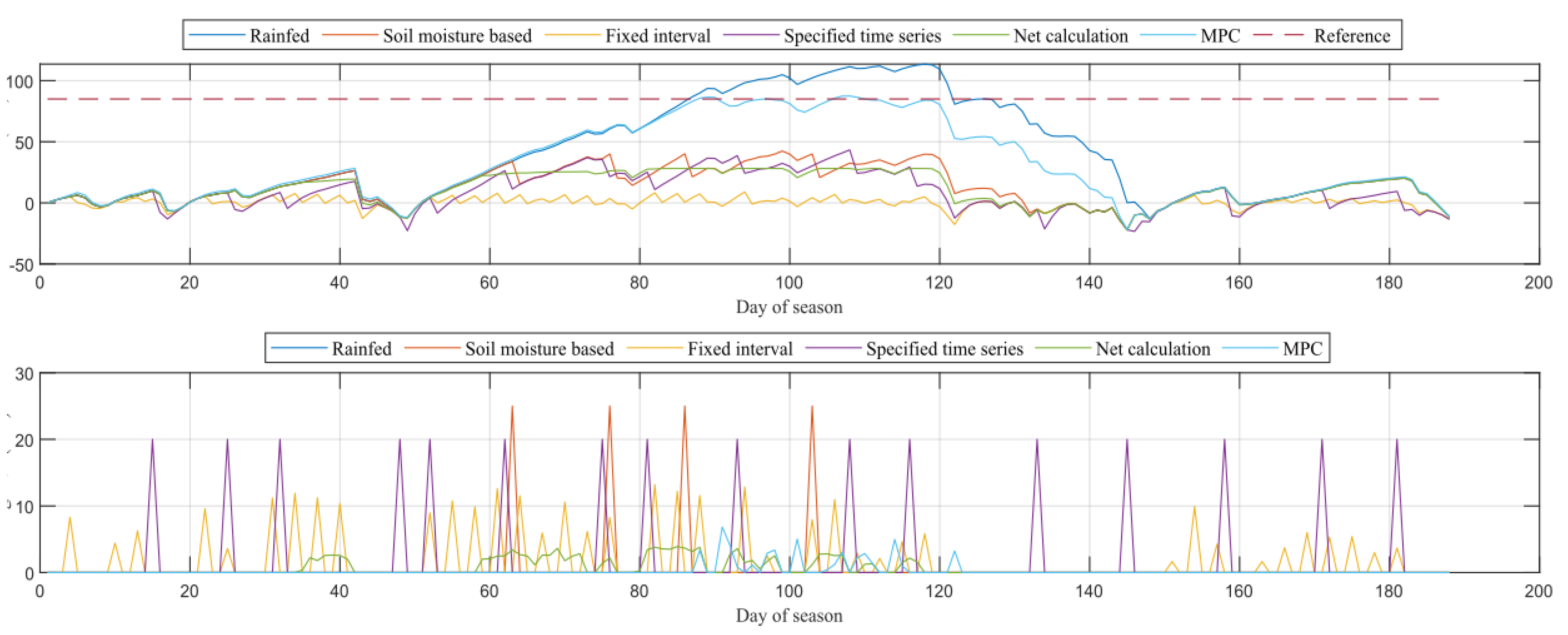Application Predictive Control Strategies Based on Models for Optimal Irrigation of Andean Crops †
Abstract
:1. Introduction
2. Methodology
2.1. Quinoa Crop
2.2. Aquacrop
2.3. Model Predictive Control
2.4. ARX Model
3. Results
Model Predictive Control in Quinoa Crop
4. Conclusions
Supplementary Materials
Author Contributions
Funding
Institutional Review Board Statement
Informed Consent Statement
Data Availability Statement
Conflicts of Interest
References
- Pltonykova, H.; Koeppel, S.; Bernardini, F.; Tiefenauer-Linardon, S. The United Nations World Water Development Report 2020: Water and Climate Change; UNESCO: Paris, France, 2020. [Google Scholar]
- Lopez-Jimenez, J.; Vande Wouwer, A.; Quijano, N. Dynamic Modeling of Crop–Soil Systems to Design Monitoring and Automatic Irrigation Processes: A Review with Worked Examples. Water 2022, 14, 889. [Google Scholar] [CrossRef]
- Lozoya, C.; Mendoza, C.; Mejía, L.; Quintana, J.; Quintana, G.; Bustillos, M.; Bustillos, O.; Solís, L. Model Predictive Control for Closed-Loop Irrigation. IFAC Proc. Vol. 2014, 47, 4429–4434. [Google Scholar] [CrossRef] [Green Version]
- Camacho, E.; Bordons, C. Control Predictivo: Pasado, presente y futuro”, Revista Iberoamericana de. Automática E Inf. Ind. (RIAI) 2004, 1, 1–28. [Google Scholar]
- Ding, Y.; Wang, L.; Li, Y.; Li, D. Model predictive control and its application in agriculture: A review. Comput. Electron. Agric. 2018, 151, 104–117. [Google Scholar] [CrossRef]
- Gu, Z.; Qi, Z.; Burghate, R.; Yuan, S.; Jiao, X.; Xu, J. Irrigation Scheduling Approaches and Applications: A Review. J. Irrig. Drain. Eng. 2020, 146. [Google Scholar] [CrossRef]
- Abioye, E.A.; Abidin, M.S.Z.; Mahmud, M.S.A.; Buyamin, S.; Ishak, M.H.I.; Rahman, M.K.A.I.; Otuoze, A.O.; Onotu, P.; Ramli, M.S.A. A review on monitoring and advanced control strategies for precision irrigation. Comput. Electron. Agric. 2020, 173, 105441. [Google Scholar] [CrossRef]
- FAO. AquaCrop, el Modelo de Productividad del Agua de los Cultivos. 2016. Available online: https://www.fao.org/3/i7455s/i7455s.pdf (accessed on 26 August 2022).
- Otiniano Mego, G.L. Calibración del Modelo Aquacrop para tres Variedades de Quinua. 2022, Tesis de Pregrado, Universidad Nacional Agraria la Molina. Available online: https://repositorio.lamolina.edu.pe/handle/20.500.12996/5427 (accessed on 15 August 2022).
- Shirazi, S.Z.; Mei, X.; Liu, B.; Liu, Y. Assessment of the AquaCrop Model under different irrigation scenarios in the North China Plain. Agric. Water Manag. 2021, 257. [Google Scholar] [CrossRef]
- Apaza, V.; Cáceres, G.; Estrada, R.; Pinedo, R. Catalogue of Commercial Varieties of Quinoa in Peru. 2015. Available online: www.fao.org/publications (accessed on 15 August 2022).
- CIRAD; FAO. State of the Art Report on Quinoa around the World in 2013–2015. Available online: http://www.fao.org/3/contents/ca682370-10f8-40c2-b084-95a8f704f44d/i4042e00.htm (accessed on 12 July 2022).
- Foster, T.; Brozović, N.; Butler, A.P.; Neale, C.M.U.; Raes, D.; Steduto, P.; Fereres, E.; Hsiao, T.C. AquaCrop-OS: An open source version of FAO’s crop water productivity model. Agric. Water Manag. 2017, 181, 18–22. [Google Scholar] [CrossRef]

| Method | Field Yield (Ton/He) | Total Irrigation (mm) |
|---|---|---|
| Rainfed | 4.31 | 0 |
| Soil moisture-based | 4.72 | 164.63 |
| Fixed interval | 4.72 | 289.26 |
| Specified time series | 4.72 | 320 |
| Net calculation | 4.72 | 160.08 |
| MPC | 4.72 | 80.17 |
Disclaimer/Publisher’s Note: The statements, opinions and data contained in all publications are solely those of the individual author(s) and contributor(s) and not of MDPI and/or the editor(s). MDPI and/or the editor(s) disclaim responsibility for any injury to people or property resulting from any ideas, methods, instructions or products referred to in the content. |
© 2023 by the authors. Licensee MDPI, Basel, Switzerland. This article is an open access article distributed under the terms and conditions of the Creative Commons Attribution (CC BY) license (https://creativecommons.org/licenses/by/4.0/).
Share and Cite
Ccama, I.B.; Semino, J.O. Application Predictive Control Strategies Based on Models for Optimal Irrigation of Andean Crops. Environ. Sci. Proc. 2022, 23, 30. https://doi.org/10.3390/environsciproc2022023030
Ccama IB, Semino JO. Application Predictive Control Strategies Based on Models for Optimal Irrigation of Andean Crops. Environmental Sciences Proceedings. 2022; 23(1):30. https://doi.org/10.3390/environsciproc2022023030
Chicago/Turabian StyleCcama, Iván Beltrán, and José Oliden Semino. 2022. "Application Predictive Control Strategies Based on Models for Optimal Irrigation of Andean Crops" Environmental Sciences Proceedings 23, no. 1: 30. https://doi.org/10.3390/environsciproc2022023030






